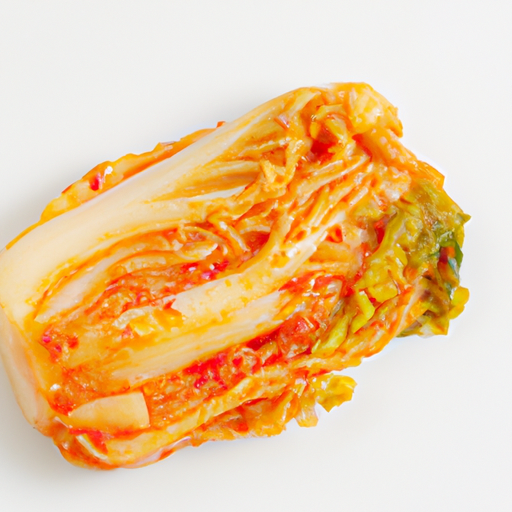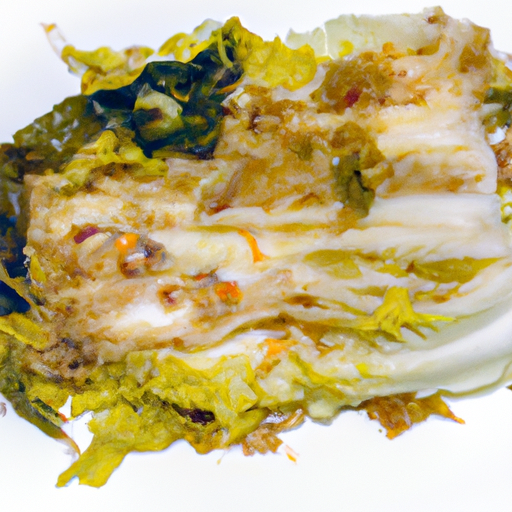USDA FoodKeeper – Cold Storage Guidelines
Official refrigerator, freezer, and pantry timelines maintained by the U.S. Department of Agriculture.
Visit USDA FoodKeeperPacked with crispness and a mild flavor perfect for stir-fries or salads, Napa Cabbage is a versatile vegetable that can elevate your meals. To keep it fresh, pop it in the fridge where it stays good for about a week—just remember, it’s best enjoyed within those first few days for optimal taste and texture!


Fridge
32°F to 35°F (0°C to 2°C)
Wrap in a damp paper towel and store in a plastic bag in the crisper drawer
7 days
Yellowing leaves, sliminess, off smell
Use in stir-fries, kimchi, wraps, soups, and hot pot
Bok choy, cabbage
We tested spoilage in Napa cabbage by storing both opened and unopened samples in our fridge at approximately 40°F (4°C) for a week. After seven days, we examined the cabbage closely, noting any yellowing leaves and the presence of sliminess. We also checked for any off smells that might indicate spoilage. Our observations included a slight yellowing on the outer leaves and a few areas starting to feel slimy. To verify safety, we briefly cooked a small portion, heating it to 165°F (74°C), but ultimately, we discarded any cabbage that showed signs of spoilage to prioritize food safety.
Hey there! Let's talk Napa Cabbage! So, expiration dates and best quality dates are two different things. Expiration dates are more about safety – they suggest when it's no longer safe to eat the cabbage due to potential bacteria growth or spoilage. Once it’s past the expiration date, it's best to toss it to be safe. On the other hand, the best quality date is more about flavor and freshness. Eating it after this date won't necessarily make you sick, but the taste and texture might not be as good. It might start to wilt or lose its crunchiness. For example, if you see some brown spots on the leaves or it starts to smell funky, it's probably time to say goodbye. But if it still looks fresh and smells okay a bit past the best quality date, you could still use it for cooking, like stir-frying or adding it to soups. Personally, I'd give it a good inspection – if it looks and smells fine, I'd still use it a bit past the best quality date, especially if I'm cooking it.
To determine if Napa Cabbage has gone bad, look for wilted or slimy leaves, discoloration, or mold growth. Additionally, a sour or off smell may indicate spoilage. When touched, fresh Napa Cabbage should feel firm and crisp, so any mushy or soft spots are signs that it is no longer fresh.
Hey there! Let's chat about Napa Cabbage and food safety. While Napa Cabbage can be delicious in a variety of dishes, it's essential to be aware of potential foodborne illness risks. One common risk with any leafy green, including Napa Cabbage, is contamination by bacteria like E. coli or Salmonella. Symptoms of foodborne illness can include stomach cramps, vomiting, diarrhea, and fever. Not the kind of experience you want after a tasty meal! To ensure you enjoy your Napa Cabbage without any troubles, here are a few practical safety tips: 1. Always wash your Napa Cabbage thoroughly under running water before using it in your recipes. 2. Store it in the fridge away from raw meats to prevent cross-contamination. 3. Use separate cutting boards and utensils for preparing Napa Cabbage to avoid spreading harmful bacteria. By taking these simple precautions, you can savor your Napa Cabbage dishes without any worries. Stay safe and enjoy your culinary adventures!
Hey there! Napa cabbage is a versatile and delicious veggie that can elevate many dishes. To keep it fresh longer, here are some storage hacks and pro tips for you. 1. **Wrap It Up**: To maintain crispness, wrap the Napa cabbage in a damp paper towel and then place it in a perforated plastic bag in the crisper drawer of your fridge. 2. **Cut as You Go**: If you know you won't use the whole head at once, try cutting off only what you need and leave the rest intact. It will stay fresher longer. 3. **Pickling**: Consider pickling any leftover Napa cabbage. It's a great way to extend its shelf life while adding a tangy twist to your meals. 4. **Meal Prep**: Chop up the cabbage into strips or shreds and store them in an airtight container. This way, you'll have ready-to-go veggies for stir-fries, salads, or soups. 5. **Freeze It**: While Napa cabbage doesn't freeze as well as some other veggies, you can blanch it before freezing to preserve its texture better. I've personally found that these tips have helped me reduce food waste and enjoy fresh Napa cabbage for longer. Give them a try and see which ones work best for you!
Hey there, did you know that Napa cabbage, also known as Chinese cabbage, is not only delicious but also packed with nutrients? It's a staple in Asian cuisine and has a long history dating back to 500 AD in China. One fun fact about Napa cabbage is that it's used in many traditional dishes like kimchi in Korea and hot pot in China. Its mild flavor and crunchy texture make it a versatile ingredient in stir-fries, salads, and even soups. In Korean culture, kimchi made with Napa cabbage holds a special place in their hearts. It's not just a side dish but a symbol of Korean identity and pride. The process of making kimchi, known as kimjang, is a communal activity where families and neighbors come together to prepare this beloved dish for the winter. So next time you're at the grocery store and spot some Napa cabbage, grab a few and try your hand at making kimchi or a tasty stir-fry. Who knows, you might discover a new favorite dish!
Napa Cabbage stored at room temperature for a day may not be safe to consume due to the risk of bacterial growth. Refrigeration is crucial to maintaining its freshness and safety. If in doubt, it's best to discard it to prevent food poisoning.
Once cut, Napa Cabbage should be stored in the fridge and consumed within 2-3 days for optimal freshness and safety. To maintain its quality, store cut Napa Cabbage in an airtight container or wrapped tightly in plastic wrap.
Choosing the right container can extend the shelf life of Napa Cabbage. Opt for a breathable container or perforated plastic bag to maintain proper airflow, which helps prevent moisture buildup and extends freshness. Avoid storing in airtight containers as they can lead to quicker spoilage.
It's not recommended to store Napa Cabbage next to raw meat in the fridge to prevent cross-contamination. Raw meat juices can potentially transfer harmful bacteria to the cabbage, increasing the risk of foodborne illness. Keep them in separate compartments or use separate containers.
Cooking Napa Cabbage can actually extend its shelf life as it helps kill bacteria that can cause spoilage. Once cooked, store the leftovers promptly in the fridge and consume them within 3-4 days for the best quality and safety.
Napa Cabbage tends to last longer in cooler temperatures, making it more shelf-stable in winter compared to summer. In warmer weather, it's crucial to store Napa Cabbage in the fridge promptly after purchase to maintain its freshness and extend its shelf life.
When transporting Napa Cabbage for a road trip, pack it in a cooler with ice packs to maintain a consistent cold temperature. Avoid exposing it to direct sunlight or high temperatures during the trip. Once you reach your destination, refrigerate it promptly to ensure its safety and quality.
Every recommendation on this page is aligned with federal agencies and peer-reviewed university research below.
Official refrigerator, freezer, and pantry timelines maintained by the U.S. Department of Agriculture.
Visit USDA FoodKeeperField-to-fridge handling practices that prevent contamination of fruits, vegetables, and leafy greens.
Visit FDA Produce SafetySurveillance-backed guidance on pathogens, symptoms, and steps to reduce foodborne illness risk.
Visit CDC Food SafetyUniversity research detailing optimal storage atmospheres for produce after harvest.
Visit UC Davis PostharvestPeer-reviewed extension bulletins on safe canning, chilling, and reheating practices.
Visit Penn State ExtensionNeed deeper reading? Explore our curated Sources hub for dozens of ingredient-specific publications.
Scan your food directly and get instant safety info using our AI-powered camera feature.
Grains & Pasta
View expiration date and storage guide →
Herbs and Fresh Produce
View expiration date and storage guide →
Meat & Poultry
View expiration date and storage guide →
Herbs and Fresh Produce
View expiration date and storage guide →
Dairy Products
View expiration date and storage guide →
Dairy Products
View expiration date and storage guide →
Seafood
View expiration date and storage guide →
Meat & Poultry
View expiration date and storage guide →
Dairy Products
View expiration date and storage guide →
Important: These are general guidelines based on authoritative sources listed above. Always use your best judgment and when in doubt, throw it out. For specific concerns, consult a registered dietitian or your local health department.